Chronic
In 1842 Mrs James Foster of Stamford Hill had been moved by pity for the helplessness and loneliness of two invalids she had seen leaving the Invalid Asylum in her neighbourhood. She took a small house in Birdcage Walk and, with the assistance of Lady Kinnaird and the Hon. Mrs Baptist Noel, opened a 'Home for Confirmed Invalids'. Its objective was to provide comfortable accommodation for chronically ill women, whose sufferings could be alleviated by care and attention.
The two invalids Mrs James had seen - Harriet Munsen and Annie Alston - were the first residents. For the next 20 years Mr and Mrs Foster contributed £960 towards the expenses of the Home. They also bequeathed £1,000 in a will, which became the Home's invested capital.The premises became inadequate and the Home moved to Canonbury, then to Manor House in Highbury. Soon, more accommodation was needed and, as the lease was due to expire, it was decided to build a house. Contributions for the building fund were collected from old friends and neighbours, and grants were obtained from the Corporation of London and various City Companies, such as the Worshipful Company of Bowyers.
The new Home, at 36 Aubert Park, opened in 1884 with 30 beds. It was supported partly by donations and subcriptions, and partly by the payments of its residents. Each donor of £5 and upwards and each subscriber of 1 guinea (£1.05) could recommend an inmate (as could two subscribers of 10s 6d (53p) or four subscribers of 5s 6d (27p) annually).
Patients were admitted on three months' probation. Each applicant had to produce a testimonial from the donor or subscriber as to her character, and two competent guarantors to make sure that the payments would be made quarterly or half-yearly in advance, that she would be supplied with suitable clothing, and that her body would be removed within 12 hours of death. A month's notice or a month's payment in lieu was required on leaving.
The residents had to sign a paper agreeing to above by the rules of the Home. Each was provided with everything she needed, apart from clothing, wine and brandy. All medicines, spiritous liquors and wine were placed under Matron's care and only administered under medical direction.Occupation was seen as a great advantage, both morally and physically, and the patients were expected to share in light household chores, if able, or to employ themselves in needlework for the benefit of the institution.
Visitors were allowed (one at a time) in the afternoon of the 1st and the 3rd Monday of each month and on Bank Holidays (at any other times only by express leave of the Matron). Permission was also necessary from the Matron if going beyond the garden. No books were allowed to be introduced unless approved by the Council of the Home. Inmates were encouraged to attend public worship (health permitting) and expected to assemble for family devotion when able.
In 1897, to celebrate the Diamond Jubilee of Queen Victoria, the Council of the Home decided to increase the bed complement. A special appeal for funds was launched and, in 1898, the Council purchased two large freehold houses - Nos. 1 and 2, Highbury Terrace - in Islington.
The Highbury Terrace Home was officially opened by the Duchess of Albany in April 1899.
In 1905 a lease was taken on No. 3, Highbury Terrace.
By 1918 the Home had 70 female residents - 40 at Highbury Terrace and 30 at Aubert Park. The average weekly cost of an in-patient was £1 13s 4d (£1.67), which rose to £1 18s 6d (£1.92) in 1919.
In 1938 it had 68 beds, but the Aubert Park building joined the Emergency Medical Scheme with 30 beds at the outbreak of WW2 in 1939 and never reopened after the war.
The Home at Highbury Terrace joined the NHS in 1948, under the control of the Archway Group Hospital Management Committee, part of the North West Metropolitan Regional Hospital Board. It had 31 beds.
By 1950 it had 36 beds.
In 1962 the Home had 32 beds and the weekly cost of an in-patient was £13 7s 4d (£13.37), compared to the previous year, when it was £13 3s 11d (£13.20).
The oldest established home for female incurables in or near London, it closed in 1965. Its first patient, Harriet Munsen, had died after 30 years of care, while another invalid completed her 50th year of residence.
Present status (February 2009)
Both sites of the Home are now multiple-occupancy dwellings.
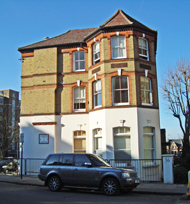
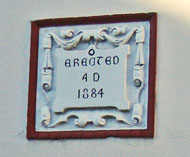
No. 36 Aubert Park (southern elevation) with dated plaque on the front of the house.
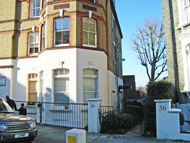
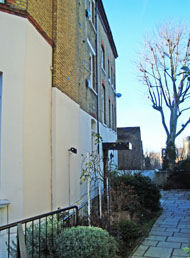
The present main entrance is to the east side of the house via a path leading off Aubert Park.
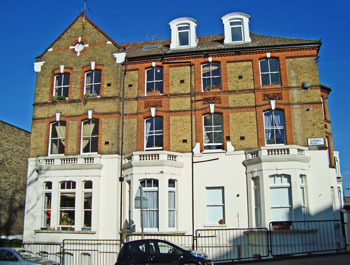
Western elevation on Avenell Road
36 Aubert Park (above)
1-3 Highbury Terrace (below)
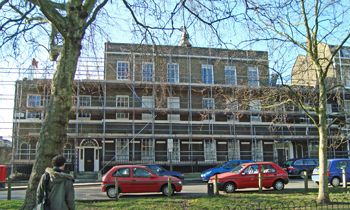
1-3 Highbury Terrace (above and below) is at the eastern end of the Terrace facing across Highbury Fields. It is about 10 minutes walk south from Aubert Park.
The block was being refurbished when this photograph was obtained in February 2009.
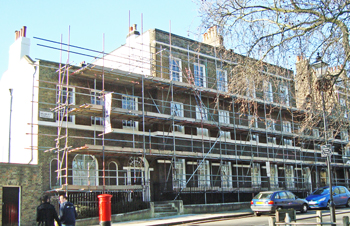
(Author unstated) 1889 Our institutions: a record of their objects and work. The Home for Confirmed Invalids. The Nursing Record, 14th March, 174.
Return to home page